Introduction
Being coastal communities, both of equal distance from the city centre, Killiney and Malahide display many common characteristics. In this article we explore a number of these shared histories which link both settlements, one of the most significant being the influence of the Talbot de Malahide family over the centuries. Other common threads include the maritime defences which were put in place to thwart a Napoleonic invasion which never materialised and the railway which links both villages.
It is interesting to note that the walled estates of the dominant houses of both Killiney and Malahide have remained largely intact. Both Demesnes have now found a new purpose as important public amenities which attract visitors from around the country and further afield.

Killiney Historical Society on a guided tour of Malahide Village by Brian Dooley of Malahide Historical Society, 20th August 2024
The visiting party from Killiney Historical Society are extremely grateful to Brian Dooley and the members of Malahide Historical Society who greeted us on 20th August 2024 and brought us on a most interesting guided walk around the village followed by lunch and then a specially organised tour of Malahide Castle which was led by Cathal Dowd Smith, Curator for Malahide Castle. Our tour ended with a visit to Malahide Historical Society’s Museum which is located in the castle grounds.
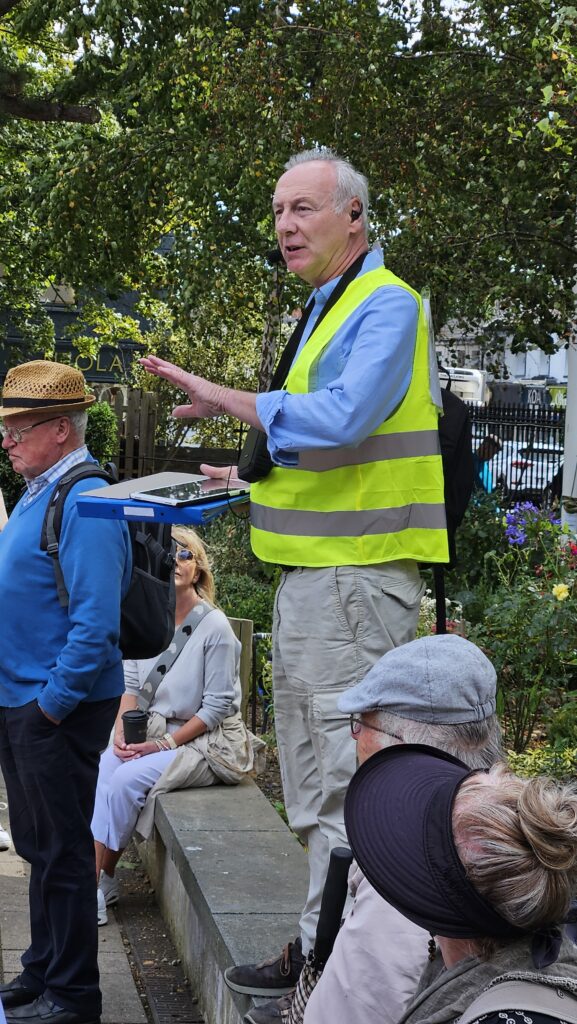
The Talbots and Malahide
King Henry II gifted Richard Talbot the lands and harbour of Malahide for his services to the crown in 1185. From that point on, the Talbot family became intertwined with Malahide’s history and development.
The original stronghold built on the lands was a wooden fortress but this was eventually superseded by a stone structure on the site of the current Malahide Castle. Over the centuries, rooms and fortifications were added, modified and strengthened until the castle took on its current form. The Talbots are reputed to have been a diplomatic family and during the eight centuries between 1185 and the 1970s, their tenure at Malahide Castle was broken for only a brief interlude between 1649 and 1660 when their lands were seized by Cromwellian soldiers and the castle was occupied by Myles Corbet, Lord Chief Baron of Ireland.
The Talbots and Killiney
ROCHESTOWN (otherwise Castletown, Dalkey). Richard Talbot I, of Malahide, Knight, living c.1193, probably had a grant of the lands later known as Castletown, Dalkey. His son and heir Reginald in 1216 was seized and in 1223 was re-seized of 400 or 500 acres here and, according to Burke, was succeeded by his brother Adam (probably living in 1251 and perhaps he who in 1235 paid a hawk as rent for the property). This from Dalkey, Co. Dublin by M.R.L. Kelly 1952 pp.42-43. Read the full transcription HERE
The family link with Killiney was broken in around 1600 and the estate, which extended from Kill of the Grange to Killiney Bay, included much of the area in the vicinity of Killiney Village. It subsequently passed to the Malpas/Mapas family but partly returned to the ownership of the Talbot family by marriage and acquisitions in 1797 after the death of John Mapas.
Lady Joyce Talbot and Lord James Boswell, 6th Baron Talbot de Malahde, lived in Malahide Castle until he died in 1948. As he had no heir his cousin Milo Reginald Talbot occupied Malahide Castle when he became 7th Baron. In 1950 the widowed Lady Joyce Talbot bought Abbey Lea in Killiney (previously called Marino) and lived there from 1950 to 1963. Her cousin by marriage was Rose Talbot de Malahide, sister of Milo, who was the last of her family to live at Malahide Castle. Rose and Milo were the children of Colonel Milo Talbot and Eva Joicey who was the landlady of much of Killiney Village in the 1930s-1940s. Read more HERE
Layout of Malahide and Killiney villages
The Diamond was planned, with a fountain in the centre, and the three main roads – New Street, Church Road and Dublin Road – re-aligned so as to radiate from there. The Mall leading to the Grand Hotel was added later. The modern road to Swords was laid out, replacing the track along the estuary. In 1792, Richard W. Talbot granted a lease for the first of the four houses that form the present-day Diamond. Subsequent development took place around this new village centre.
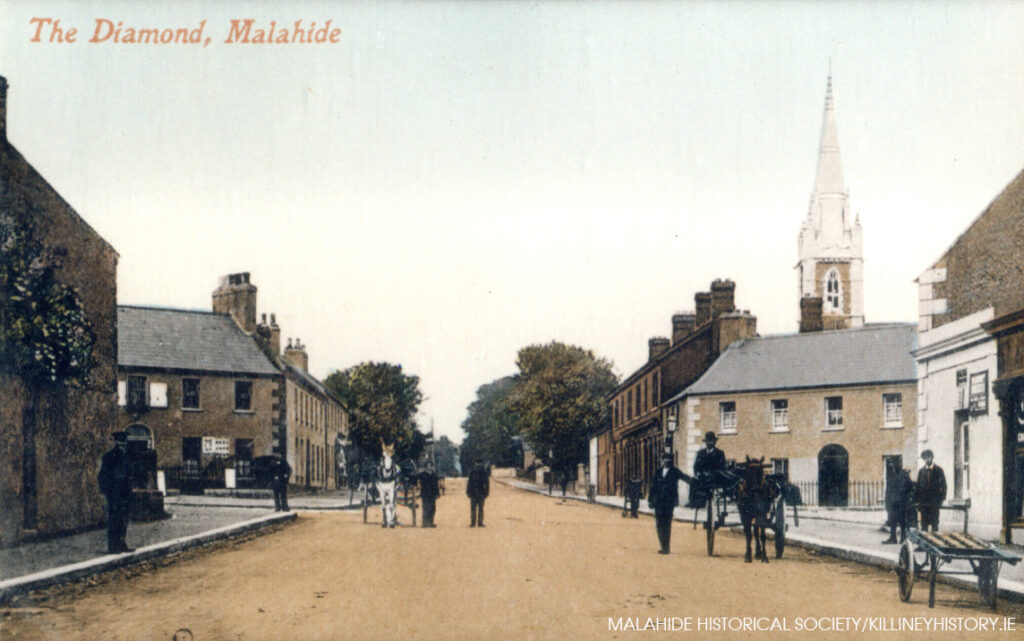
Interestingly Killiney Village once had a Diamond which we believe was the public space in front of The Druid’s Chair Pub and was mentioned in the Post Office Directory of 1858 and 1866. (Andrew Clarke esq, 1 The Diamond). The original configuration of this space was lost when the road through the village was realigned in c.1850.

The arrival of the railway
Malahide station opened on 25 May 1844 as part of the Dublin and Drogheda Railway. The design of the station has been attributed to William Hemingway Mills and the building displays his typical polychromatic brickwork style. The arrival of the railway heralded an explosion in development in the area as the town became a commuter suburb of the city.
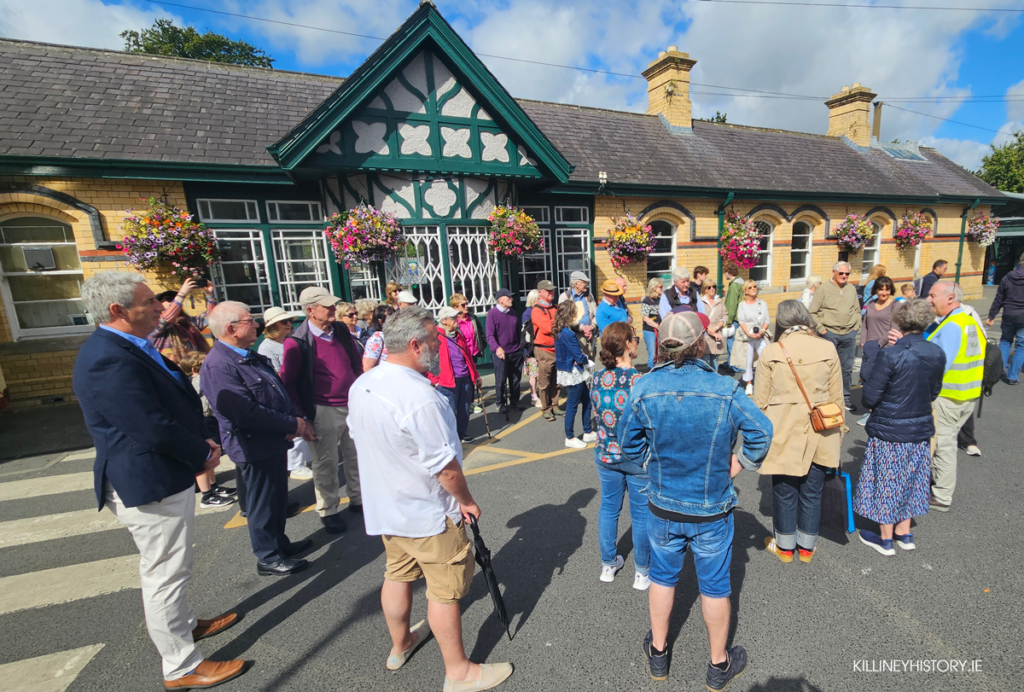
It was the arrival of the railway in Killiney and Ballybrack in 1854 which similarly led to the most significant and rapid change in the district. The number of large houses in Killiney and Ballybrack went from 65 to 122 in the ten year period from 1858 to 1868. Read about Killiney and the railway HERE
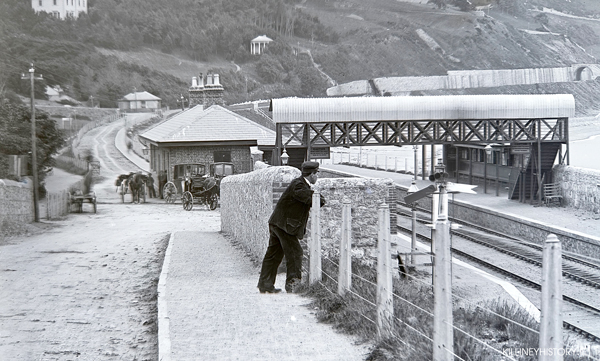
Saint Sylvester’s Church Malahide and SS. Alphonsus & Columba church Ballybrack
The church takes its name from the ancient well in Old Street (formerly Chapel Street), Malahide, that honours Sylvester, who is said to have been part of the fifth century Christian mission to Ireland. It was first built in 1845-1846. The tower and spire at Saint Sylvester’s was designed by George Coppinger Ashlin and was added in 1899.
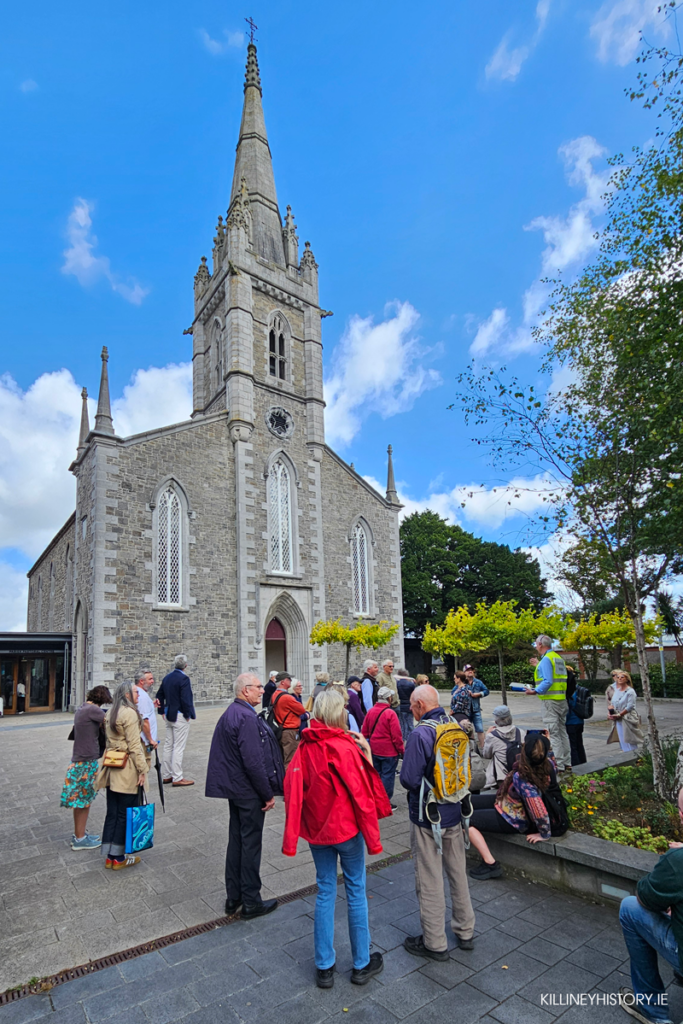
The new tower and spire of SS. Alphonsus & Columba church in Ballybrack was also designed by George Coppinger Ashlin in 1882. Ashlin designed and lived in St. George’s in Killiney with his wife Mary, the youngest daughter of Augustus W.N. Pugin.
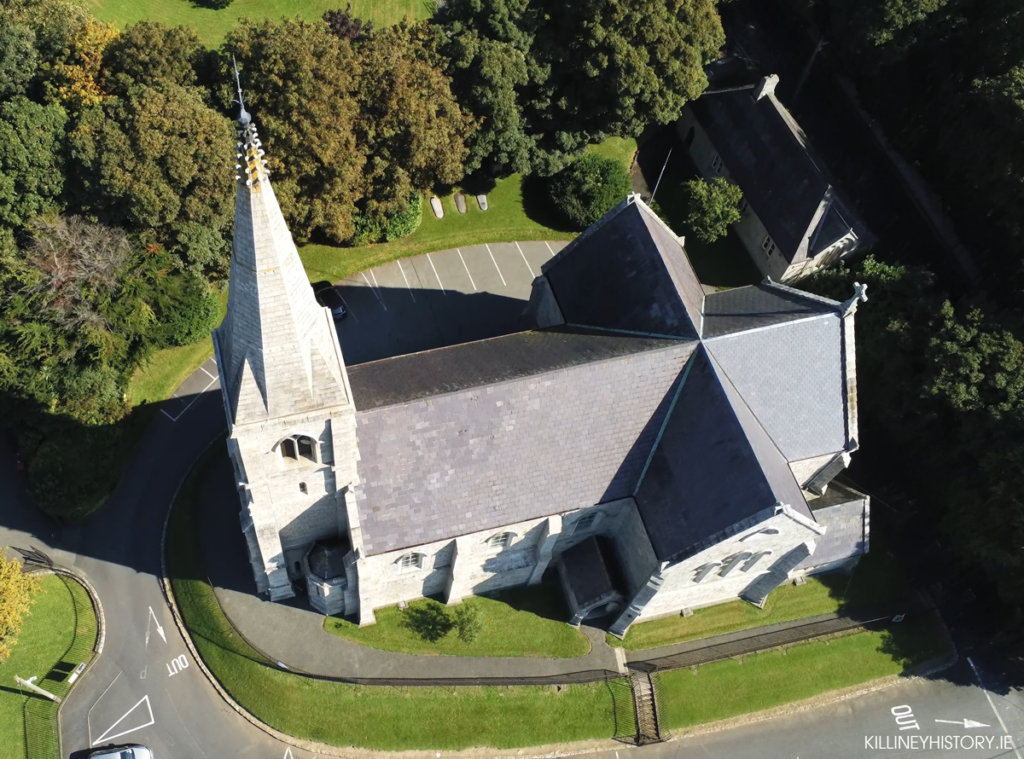
Cargo boats landing by beach
In Malahide sailing boats and small coasters carrying coal came up the estuary on the high flooding tide and sat on the hard sand off The Green when the tide later ran out. The coal was unloaded over the side into horse-drawn carts and taken over the hard sand, on to The Green and in to the coal yard where the Marina Village now sits.
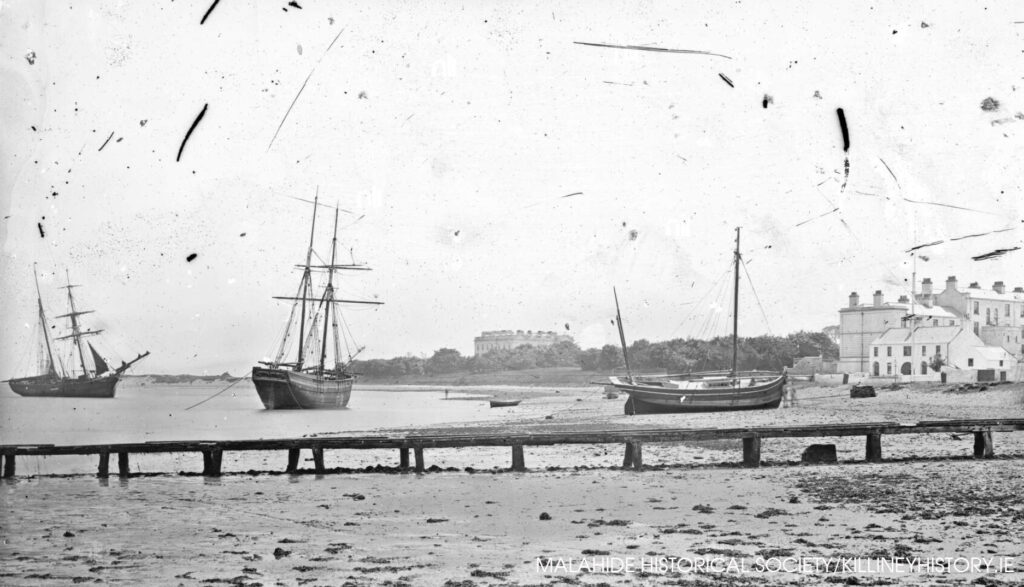
Evidence of similar activity in Killiney has been found. The image below shows a typical topsail schooner stranded on the shore at the lower end of Killiney strand where a reef of rocks can be seen at low tide. There appears to be a salvage operation in progress as the sails have been removed and a number of carts have been drawn up alongside to remove material from the boat. It is likely that the vessel is being lightened with a view to getting her off and she probably was refloated. Unfortunately we have no name for this vessel or date of beaching. An alternative interpretation of this image might suggest that this was a cargo vessel intentionally beached for offloading material. The proximity to one of the few access points to the beach from a public road supports this possibility.
Maritime historian, Cormac Lowth, mentions that it was customary along parts of the coast near Bray for small sailing colliers to come in onto the beach, and for the cargoes of coal to be discharged into horse drawn carts. There are also references to wooden smacks with cargoes of sand from Killiney Beach being brought to Dun Laoghaire.
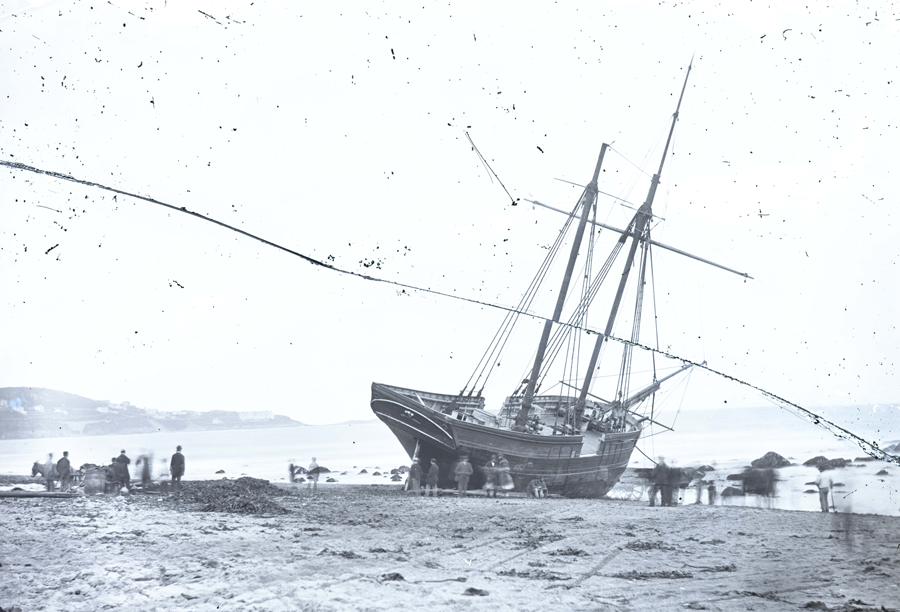
Torching of RIC Barracks
The Royal Irish Constabulary Barracks (R.I.C.) on the Diamond was where Tony Byrne’s man shop operates with the EBS building society next door. This was torched by the IRA in 1920 as part of it’s nationwide campaign of ‘denying ground’ to the Crown Forces, by destroying vacated barracks.
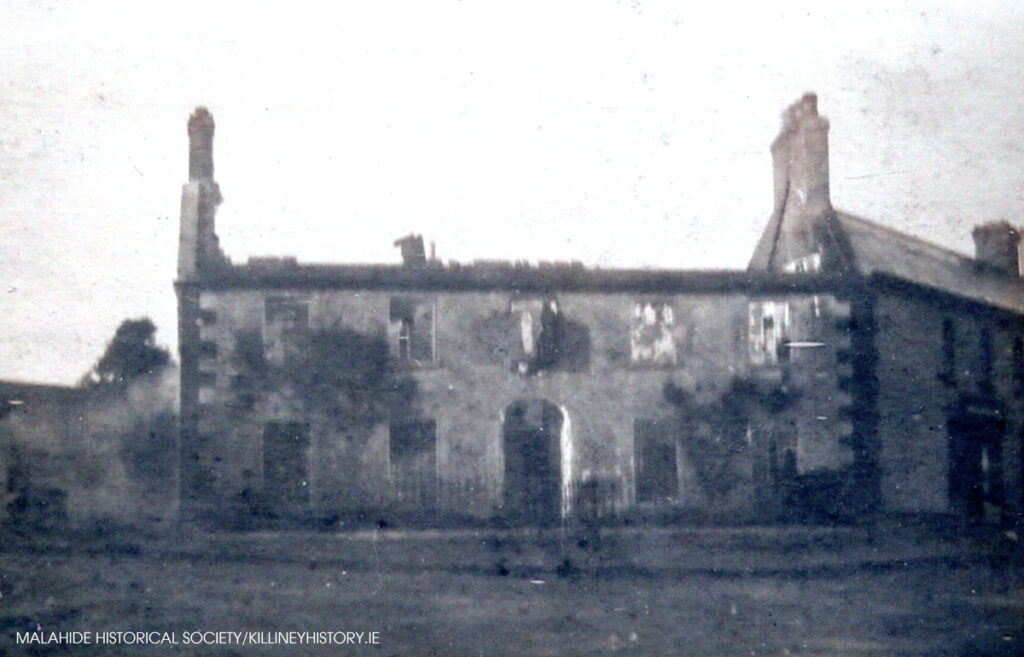
Ballybrack RIC barracks was torched on 12th May 1920. Read the article HERE
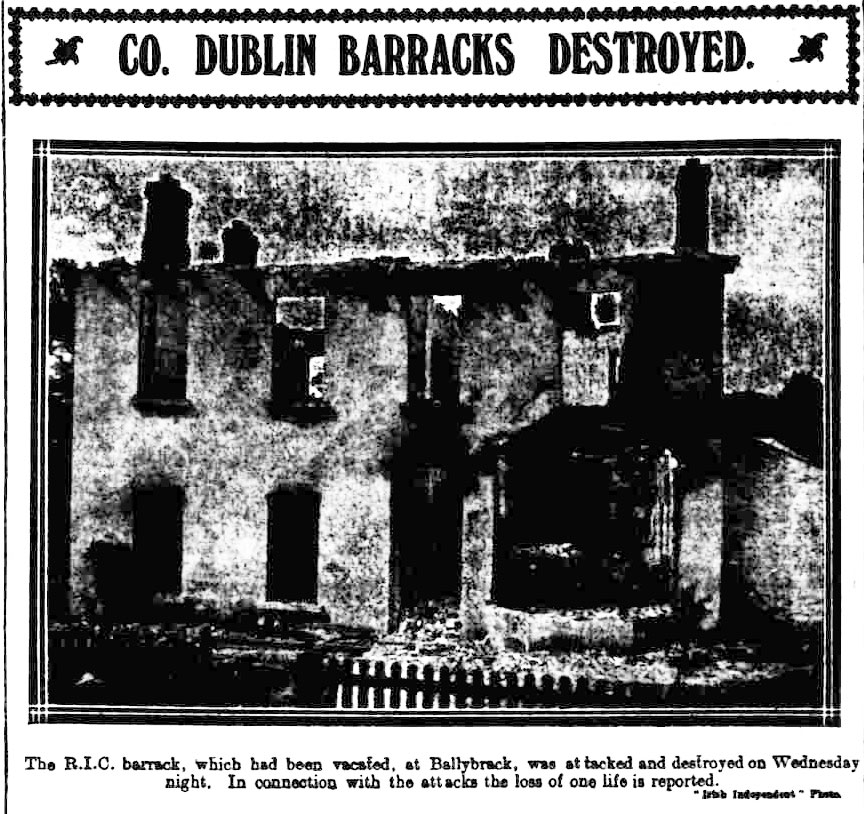
Malahide Castle and Killiney Castle
Malahide castle owes its current appearance to building work carried out in the 17th and 18th Centuries. In the 1760s the west side of the castle was destroyed in a fire. Richard Talbot and his wife Margaret (who later became 1st Baroness Talbot of Malahide) replaced them with drawing rooms complete with Rococo and neoclassical plasterwork. They also added circular towers at the north-west and south-west corners.
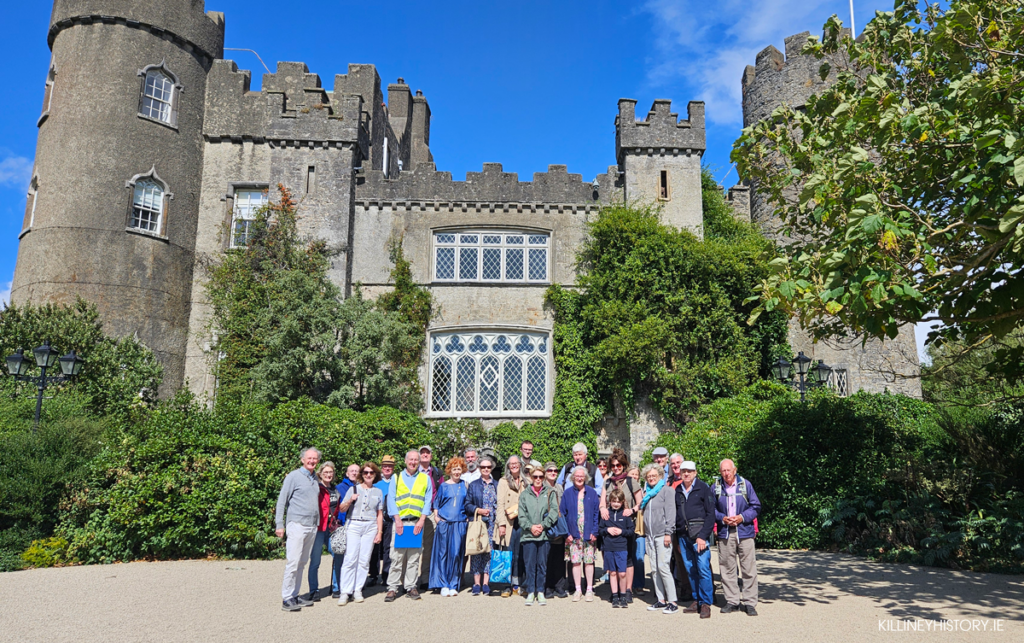
The Great Hall
Throughout history, The Great Hall would have held feasts and banquets for Lords and dignitaries and today, is a rare example of a Gaelic feasting room. The hall is home to one of the most important collections of Jacobite portraits, displayed in their original setting, and includes 31 portraits acquired by the National Gallery of Ireland. All are connected to the Talbot family of Malahide.
The hall still has a medieval feel, despite a major remodelling in 1825. Its timber roof was replaced along with the joinery and fireplaces. A minstrel’s gallery was added, featuring sixteenth and seventeenth Century carvings.

This arched doorway leads to a mural stair named after the infamous former Castle jester Puck. Doors in the 15th/16th Century were often very small as they were expensive. At that time Britain was building a huge number of ships and long straight timbers had become very difficult and expensive to buy. So builders had to make do with shorter timbers and shorter doors.

The Oak Room
The Oak Room is one of the castle’s most notable rooms. The exquisite carved panels set into the wall suggest that it was probably served as the castle’s chapel. The panels are still on display and depict scenes from the Old Testament including Adam and Eve, The Temptation and The Expulsion. Over the mantelpiece is a Flemish Coronation of the Virgin.
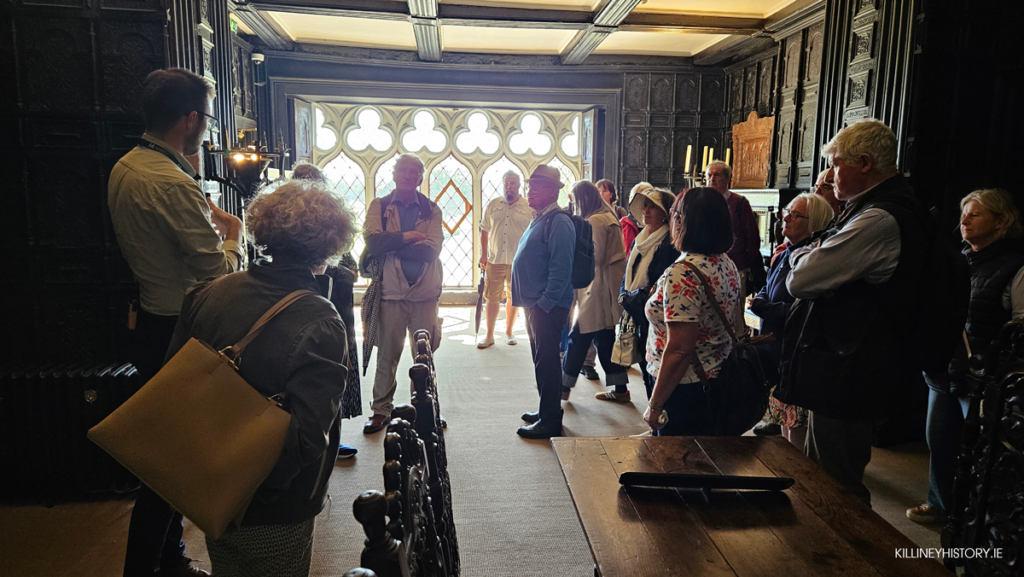
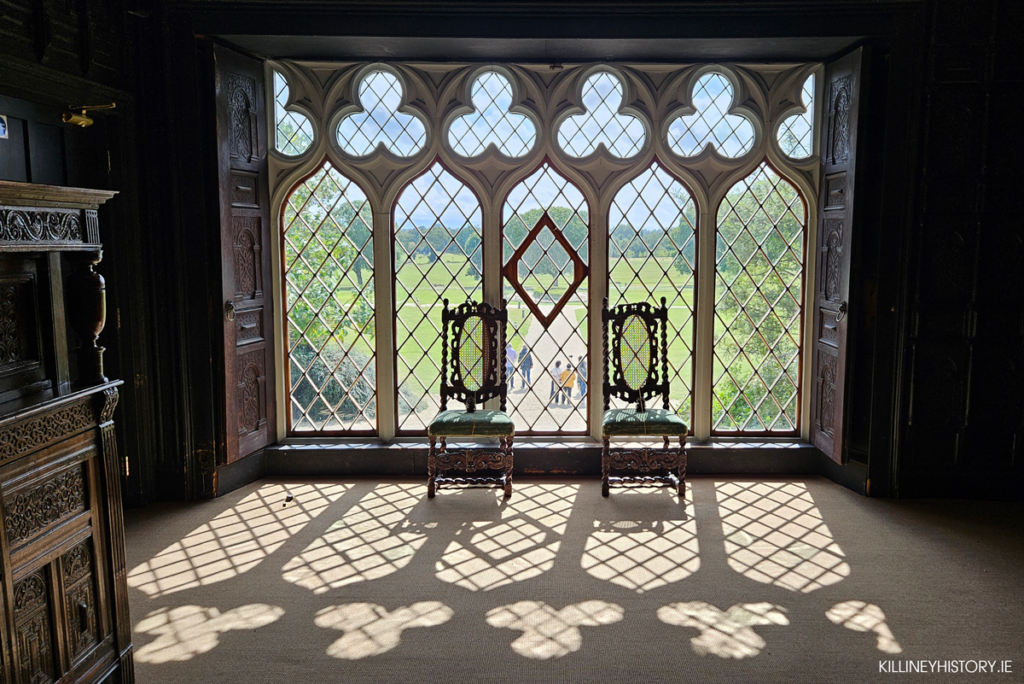
Drawing Room
In the years between 1765 and 1782, the west wing of the Castle was completely reconstructed after a fire, and the present Drawing Rooms were added. The signature Malahide Orange paintwork adorns the drawing room walls, complete with Rococo and neoclassical plasterwork. Off the drawing rooms two circular turret rooms were added and the North wing of the Castle developed.
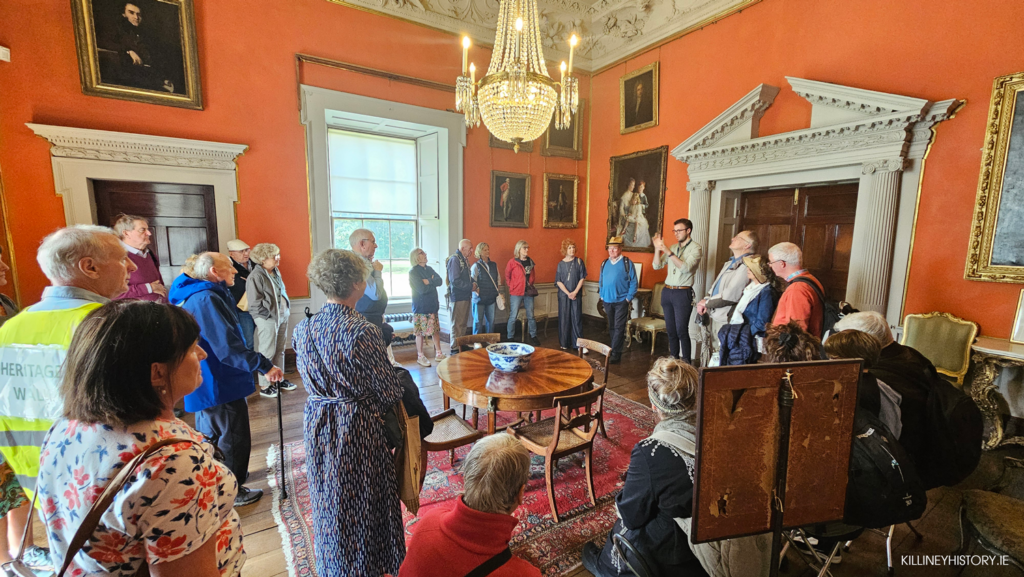
Killiney Castle and Estate
Although not really a castle this main house of the Mount Mapas Estate was upgraded by Robert Warren in 1841 with the addition of turrets and castellations which was fashionable at the time. The original structure was built as a speculation by John Malpas in 1741 and was surrounded by an enclosed deerpark of over 150 acres. We are fortunate, similarly to Malahide, that the estate has remained largely intact and is now a major public amenity in the area known as Killiney Hill Park. The park is dotted with many important monuments including the iconic Killiney Obelisk which was built in 1741. Today the main house is a popular hotel run by the Fitzpatrick Family. You can read the detailed history of the house and estate HERE

Coastal defences
In the late 18th century fear of a Napoleonic maritime invasion of Ireland convinced the military authorities that it was necessary to construct a series of defensive fortifications along the exposed coastline of the Irish Sea. This resulted in the hasty erection of a string of linked towers and batteries along with signal towers providing cover against the attack which never materialised. These fortifications were mounted with 18 and 24 pounder cannon and they stretched from Bray to Balbriggan. The works which were commenced in 1804 were completed the following year, under the direction of Colonel Benjamin Fisher.
Hick’s Tower, Robswall, Malahide
Hicks Tower looks like a small French chateau, but in fact is a former Martello tower, first built around 1805 and remodelled c.1911 as an Arts-and-Crafts style detached house. It takes its name from the architect Frederick Hicks (1870-1965), who redesigned the tower and made it his home. There are two storeys to the main tower block with two further storeys providing additional attic accommodation. The return and stair block are attached to the rear. The tower has a conical roof there is and hipped roof to right with red clay tiles and concrete ridge tiles. The tower also has an iron weathervane. There are roughcast panelled chimney stacks, and the walls are roughcast.
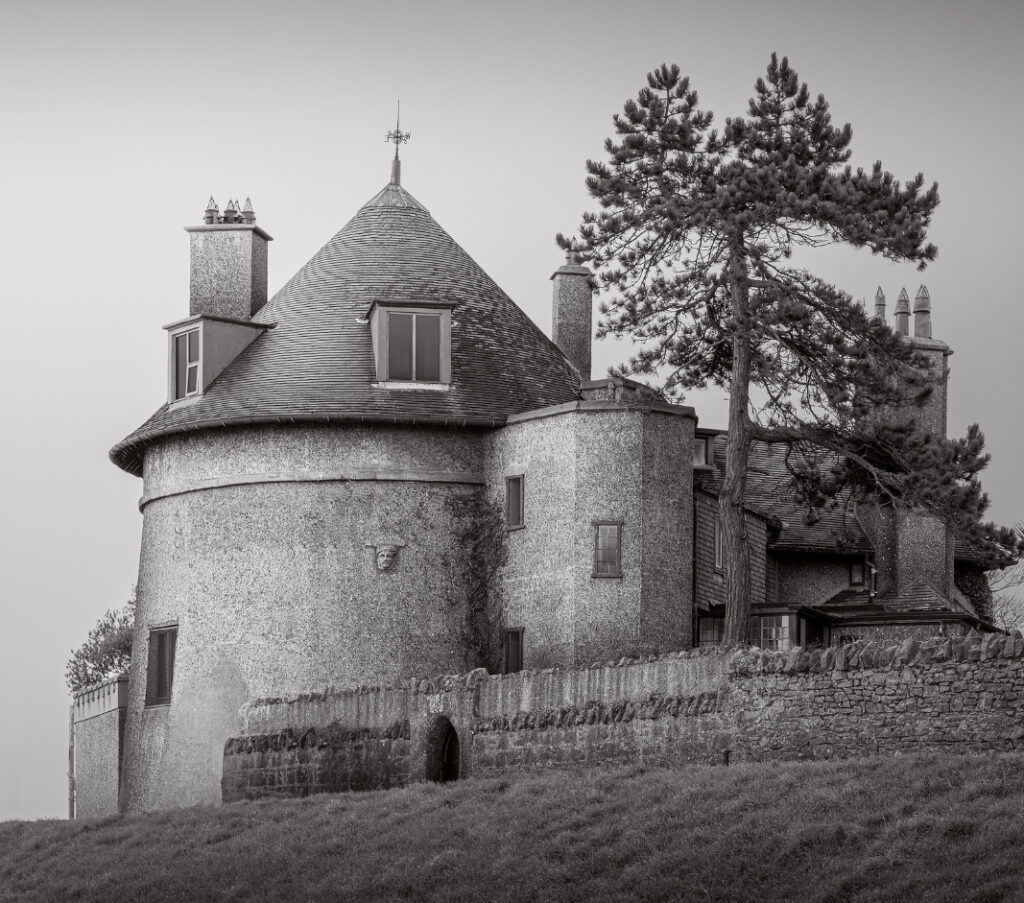
Martello Tower Number Seven, Killiney Hill Road
Martello Tower Number Seven was an enfilading fortification located on Tara Hill, Killiney Bay, some 252 feet above sea level and 400 yards inland from the sea. It is a truly unique Martello fortification being the only one that forms a combined Tower, artillery store, dry moat, and three-gun walled battery area surrounded by a steep glacis bank with a separate gunner’s cottage and gunpowder store alongside. It stands 10 metres tall and is constructed of Ashlar cut granite stone, with pitch pine flooring and joists. There was no well on the site so rain water was collected from the crown of the Tower and stored internally in a 490 gallon tank. Read more about this tower HERE
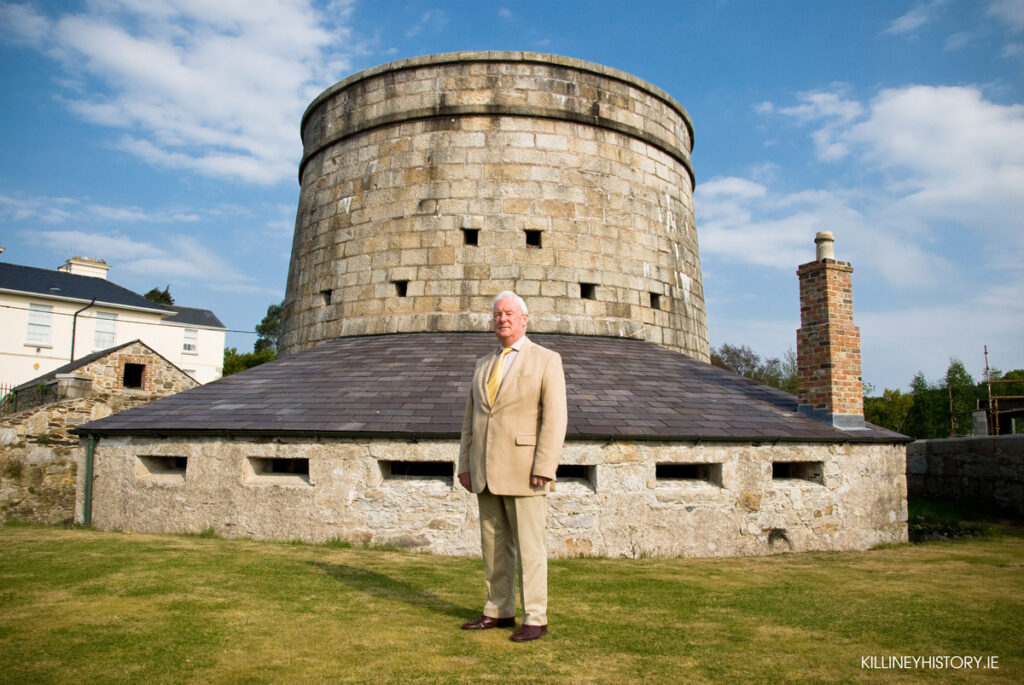
Martello Tower Number Six (Enoch’s Tower), Killiney Strand
Killiney has the distinction of having two Martello Towers due to it’s exposed position. This second tower is located at the southern end of Killiney Strand.
‘This tower was inhabited by Miss Tombe in the 1950s and 1960s. It was bought by Victor Enoch who added the two upper sun storeys and reduced the tower itself into insignificance. Subsequent building in the grounds which has now become a ruin definitively takes from any appeal this sight might have retained.‘ Pól Ó Duibhir
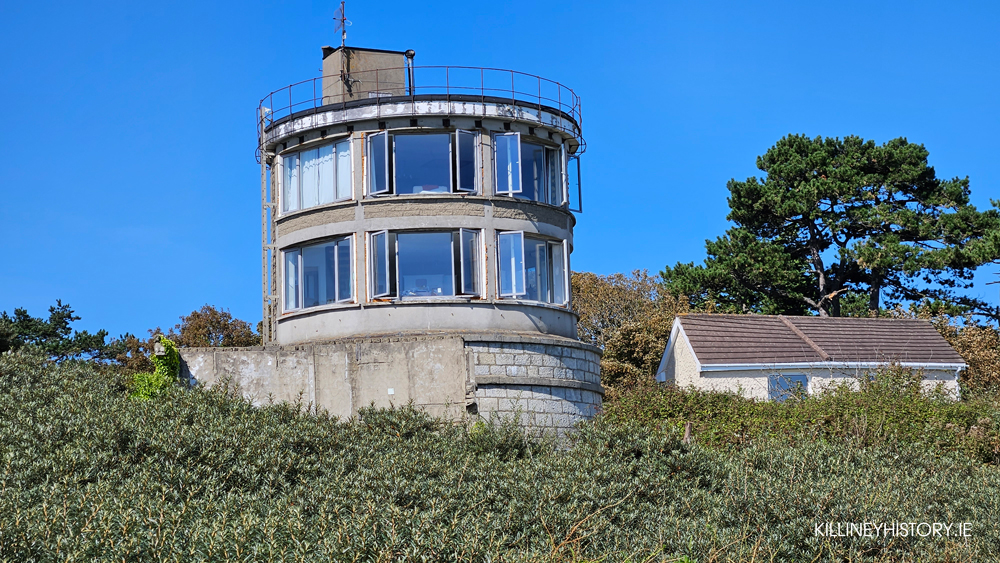
Acknowledgements
Thanks to Malahide Historical Society and Malahide Castle for the Malahide related content and we look forward to hosting MHS in Killiney next spring for a tour of the sights and monuments of Killiney.